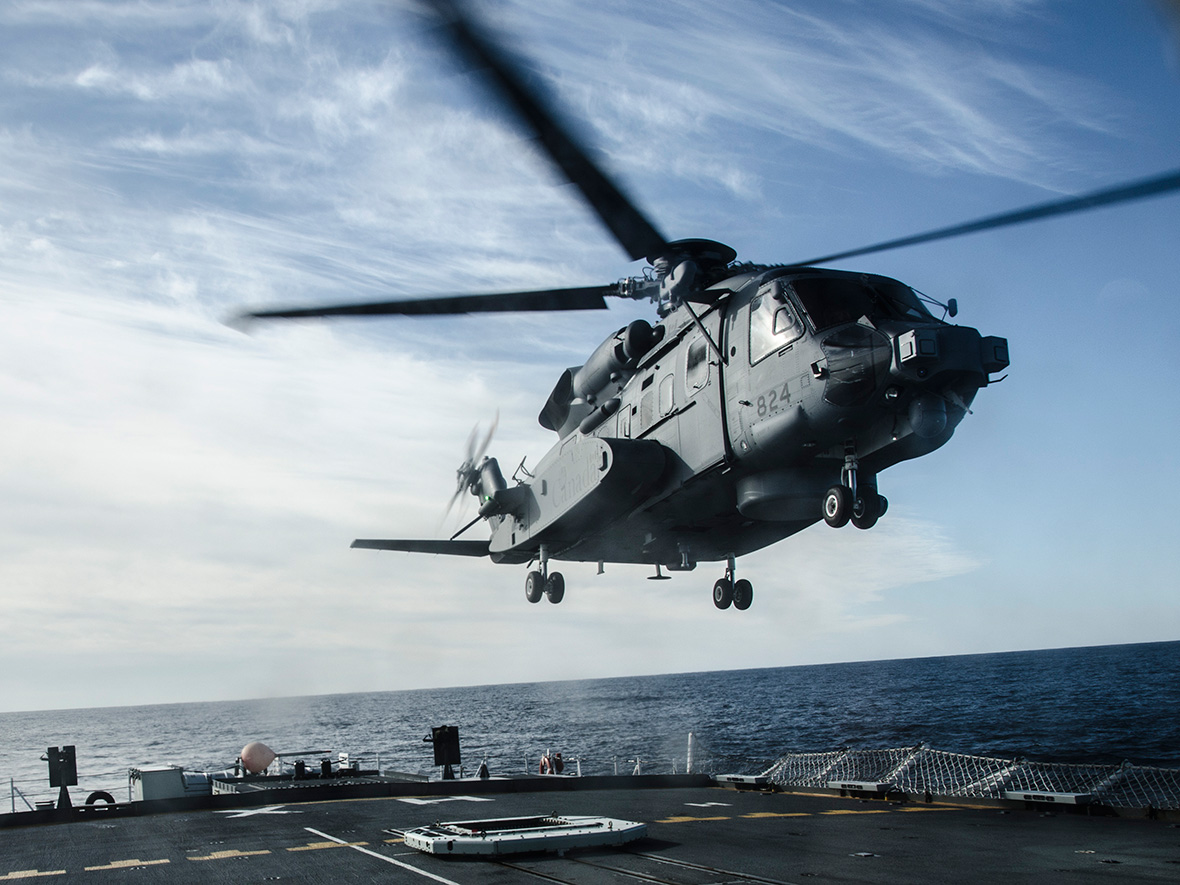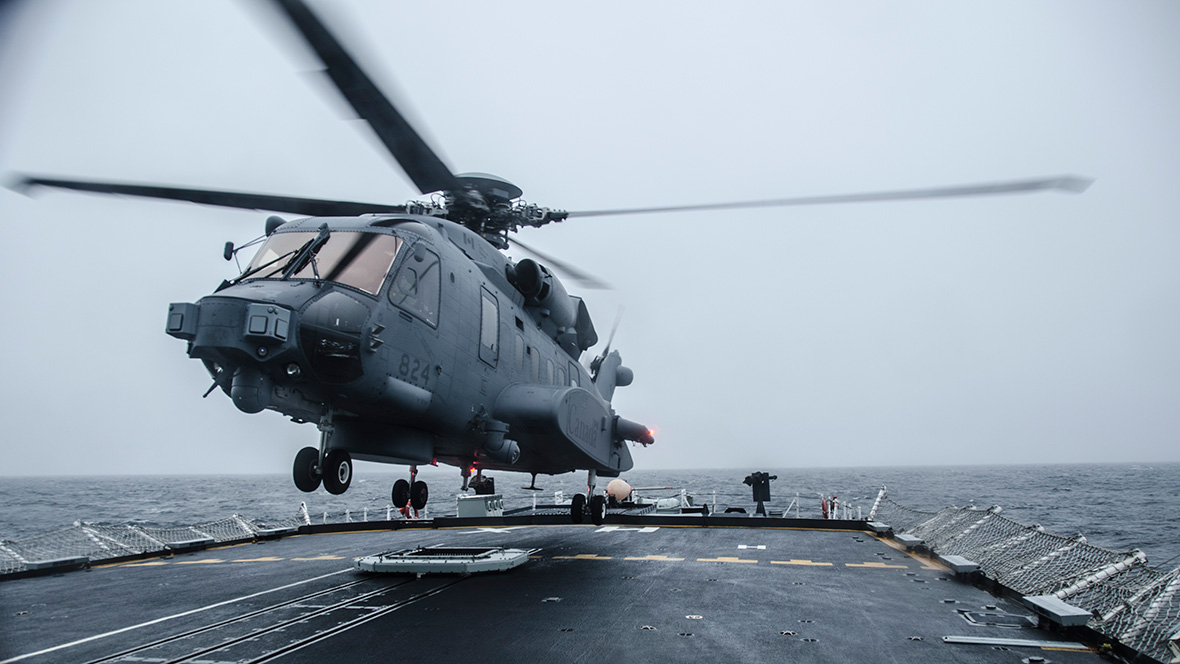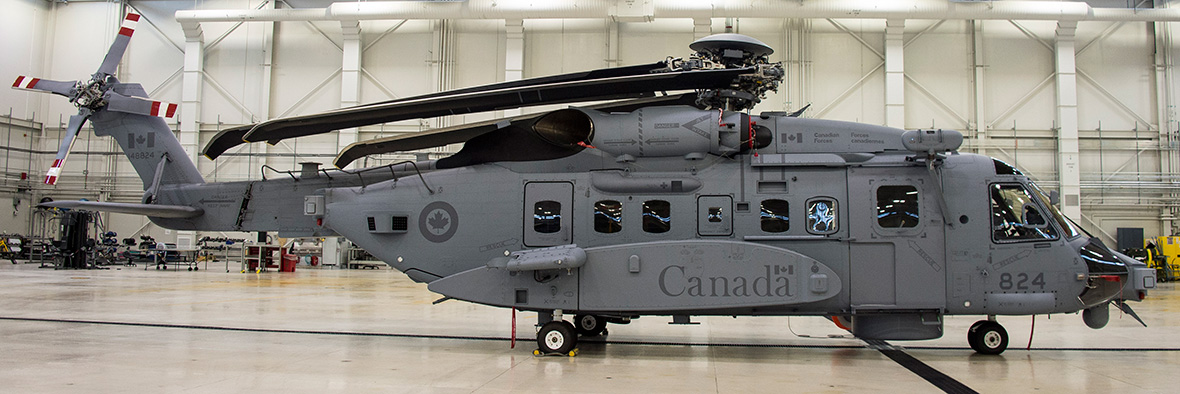CH-148 Cyclone procurement project
Project summary
The Government of Canada is procuring 28 CH-148 Cyclone helicopters. This project has a phased approach for the gradual introduction of capabilities for the Cyclone, called a “blocking strategy”. Throughout this phased approach, five versions of the Cyclone will be delivered, each version building on the configuration of the previous one. The entire fleet will be delivered in its final configuration as Capability Release 2.1.
The project includes associated logistical and in-service support, spare parts, modifications to the Halifax-class ships and construction of a new training facility. The training facility will be equipped with a full training suite of flight, mission, and maintenance simulators.
Canada’s CH-148 is a maritime helicopter that conducts anti-submarine and anti-surface warfare, search and rescue, and utility missions. The CH-148 Cyclone will provide tactical transport for national and international security efforts.
Project phases

Currently in Phase 4: Implementation
1. Identification
1. Identification
- Preliminary project approval: June 18, 2003
2. Options analysis
2. Options analysis
- June 18, 2003
3. Definition
3. Definition
- Project approval: June 18, 2003
4. Implementation
4. Implementation
- Request for proposal release: December 17, 2003
- Request for proposal close: May 14, 2004
- Bid evaluation complete: August 2004
- Project approval: November 22, 2004
- Contract award: November 23, 2004
- Contract re-baseline to define and implement a blocking strategy for helicopter delivery: June 18, 2014
- First delivery of Block 1 aircraft: June 19, 2015
- Last contract amendment: August 3, 2016
- Initial operational capability: June 7, 2018
- First delivery (Block 2): April 3, 2018
- Block 2.1 aircraft cleared for operations: November 2021
- Final delivery (Block 2): Fall 2025
- Project Full operational capability: Under review
5. Close-out
5. Close-out
- Project closeout: 2023
Learn more about the Defence procurement process.
Additional information
Project updates
Project updates
July 2025
A total of 27 Cyclone helicopters have been delivered to Canada since June 2015, with one aircraft (STALKER-22) having been tragically lost at sea in April 2020.
Summer 2024
All embarked helicopters are in the Block 2.1 configuration.
November 2021
The 24th Block 2 helicopter was accepted.
October 2021
The 23rd Block 2 helicopter was accepted.
March 2021
First capability release 2.1 Modification kit delivered to Canada.
February 2021
The second capability release 2.1 helicopter was accepted.
November 2020
First capability release 2.1 helicopter, which is the final configuration, was accepted.
September 2020
Last qualification flight for the capability release 2.1 configuration. This marked the end of the Cyclone joint Sikorsky-Canada developmental flight test program under the capital acquisition project.
November 29, 2019
The thirteenth Block 2 helicopter was accepted. The total number of Canada’s Cyclone helicopters is 19.
February 2019
Two East and West coast based Cyclones embarked on RCN ships for 6 month concurrent deployments.
The ninth Block 2 helicopter was accepted, bringing the total number of Canada's Cyclone helicopters to 17.
January 2019
The eighth Block 2 helicopter was accepted, bringing the total number of Canada's Cyclone helicopters to 16.
August 8, 2018
Patricia Bay commenced flight operations.
June 7, 2018
Initial Operational Capability achieved.
August 24, 2017
The CH-148 Cyclone release to service was issued by the Commander of the Royal Canadian Air Force.
June 2015
Six Block 1 aircraft were delivered. Block 1 aircraft were Canada’s first six Cyclones, based at Shearwater.
June 18, 2014
Contract Amendment 004 was signed, defining and implementing a blocking strategy for helicopter delivery.
February 2010
The Cyclone entered its first trials with a Canadian Patrol Frigate.
November 2008
The Cyclone flew for the first time.
Industry
Benefiting Canadian Industry
Industry engagement was conducted prior to the Request for Proposal being published in December 2003.
The Industrial and Regional Benefits (IRB) Policy was applied to the Acquisition and In-Service Support contracts. As of May 2018, 100% of the acquisition contract's $2 billion IRB has been reinvested into Canada. As of May 2021, $2 billion of the $2.8 billion IRB from the In-Service Support contract has been reinvested an additional $769 million currently being invested.
Additional information:
Contractors
Technical information
Technical information
CH-148 Cyclone technical specifications
- Fuselage width (with stabilizer): 3.89 metres (5.18 metres)
- Height: 5.59 metres
- Fuselage length: 17 metres
- Maximum take-off weight: 13,000 kilograms
- Slung cargo load: 3100 kilograms
- Maximum speed: 287 kilometres per hour (155 knots)
- Cruise speed: 222 kilometres per hour (120 knots)
- Armament:
- 2 MK 46 torpedoes
- Door and ramp mounted general purpose machine guns
- Crew: 4
- Two pilots
- One tactical operator
- One sensor operator
- Estimated life expectancy: 25 years
Project costs
Project costs
The cost for the acquisition of the CH-148 Cyclone, including project management costs, infrastructure, contracts and contingency, is $3.75 billion.
The cost for major in-service support is $11.17 billion.
Issues/Risks
Issues/Risks
Due to various compounding factors, the aircraft have not been able to meet expected flight hours, resulting in additional funding being required to operate and maintain the fleet. These factors include:
- delays to aircraft delivery, resulting in fewer aircraft being available to fly;
- challenges with obtaining parts and components due to global supply chain issues;
- the quality of some parts being less reliable than expected;
- increased inflation;
- serviceability challenges due to reduced numbers of available and experienced maintenance staff; and
- reduced numbers of aircrew staff available to fly the aircraft.
As a result, in-service support costs have been increased to address the above factors and to increase the number of flight hours for the fleet.



